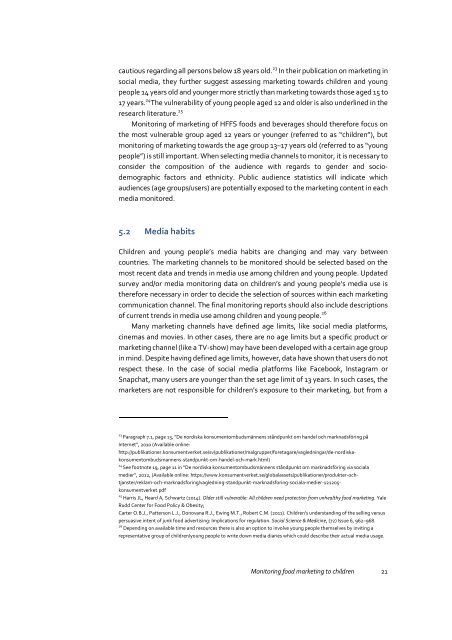TN2018504
You also want an ePaper? Increase the reach of your titles
YUMPU automatically turns print PDFs into web optimized ePapers that Google loves.
cautious regarding all persons below 18 years old. 23 In their publication on marketing in<br />
social media, they further suggest assessing marketing towards children and young<br />
people 14 years old and younger more strictly than marketing towards those aged 15 to<br />
17 years. 24 The vulnerability of young people aged 12 and older is also underlined in the<br />
research literature. 25<br />
Monitoring of marketing of HFFS foods and beverages should therefore focus on<br />
the most vulnerable group aged 12 years or younger (referred to as “children”), but<br />
monitoring of marketing towards the age group 13–17 years old (referred to as “young<br />
people”) is still important. When selecting media channels to monitor, it is necessary to<br />
consider the composition of the audience with regards to gender and sociodemographic<br />
factors and ethnicity. Public audience statistics will indicate which<br />
audiences (age groups/users) are potentially exposed to the marketing content in each<br />
media monitored.<br />
5.2 Media habits<br />
Children and young people’s media habits are changing and may vary between<br />
countries. The marketing channels to be monitored should be selected based on the<br />
most recent data and trends in media use among children and young people. Updated<br />
survey and/or media monitoring data on children’s and young people’s media use is<br />
therefore necessary in order to decide the selection of sources within each marketing<br />
communication channel. The final monitoring reports should also include descriptions<br />
of current trends in media use among children and young people. 26<br />
Many marketing channels have defined age limits, like social media platforms,<br />
cinemas and movies. In other cases, there are no age limits but a specific product or<br />
marketing channel (like a TV-show) may have been developed with a certain age group<br />
in mind. Despite having defined age limits, however, data have shown that users do not<br />
respect these. In the case of social media platforms like Facebook, Instagram or<br />
Snapchat, many users are younger than the set age limit of 13 years. In such cases, the<br />
marketers are not responsible for children’s exposure to their marketing, but from a<br />
23<br />
Paragraph 7.1, page 13, ”De nordiska konsumentombudsmännens ståndpunkt om handel och marknadsföring på<br />
Internet”, 2010 (Available online:<br />
http://publikationer.konsumentverket.se/sv/publikationer/malgrupper/foretagare/vagledningar/de-nordiskakonsumentombudsmannens-standpunkt-om-handel-och-mark.html)<br />
24<br />
See footnote 19, page 11 in “De nordiska konsumentombudsmännens ståndpunkt om marknadsföring via sociala<br />
medier”, 2012, (Available online: https://www.konsumentverket.se/globalassets/publikationer/produkter-och-<br />
tjanster/reklam-och-marknadsforing/vagledning-standpunkt-marknadsforing-sociala-medier-121205-<br />
konsumentverket.pdf<br />
25 Harris JL, Heard A, Schwartz (2014). Older still vulnerable: All children need protection from unhealthy food marketing. Yale<br />
Rudd Center for Food Policy & Obesity;<br />
Carter O.B.J., Patterson L.J., Donovana R.J., Ewing M.T., Robert C.M. (2011). Children’s understanding of the selling versus<br />
persuasive intent of junk food advertising: Implications for regulation. Social Science & Medicine, (72) Issue 6, 962–968.<br />
26 Depending on available time and resources there is also an option to involve young people themselves by inviting a<br />
representative group of children/young people to write down media diaries which could describe their actual media usage.<br />
Monitoring food marketing to children 21


